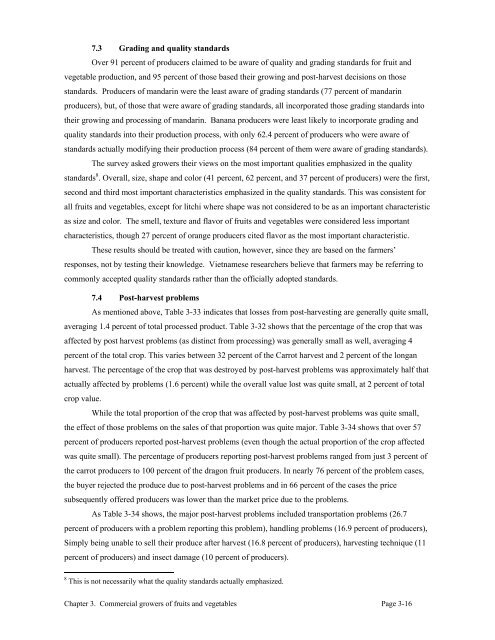Fruits and Vegetables in Vietnam - International Food Policy ...
Fruits and Vegetables in Vietnam - International Food Policy ...
Fruits and Vegetables in Vietnam - International Food Policy ...
You also want an ePaper? Increase the reach of your titles
YUMPU automatically turns print PDFs into web optimized ePapers that Google loves.
7.3 Grad<strong>in</strong>g <strong>and</strong> quality st<strong>and</strong>ards<br />
Over 91 percent of producers claimed to be aware of quality <strong>and</strong> grad<strong>in</strong>g st<strong>and</strong>ards for fruit <strong>and</strong><br />
vegetable production, <strong>and</strong> 95 percent of those based their grow<strong>in</strong>g <strong>and</strong> post-harvest decisions on those<br />
st<strong>and</strong>ards. Producers of m<strong>and</strong>ar<strong>in</strong> were the least aware of grad<strong>in</strong>g st<strong>and</strong>ards (77 percent of m<strong>and</strong>ar<strong>in</strong><br />
producers), but, of those that were aware of grad<strong>in</strong>g st<strong>and</strong>ards, all <strong>in</strong>corporated those grad<strong>in</strong>g st<strong>and</strong>ards <strong>in</strong>to<br />
their grow<strong>in</strong>g <strong>and</strong> process<strong>in</strong>g of m<strong>and</strong>ar<strong>in</strong>. Banana producers were least likely to <strong>in</strong>corporate grad<strong>in</strong>g <strong>and</strong><br />
quality st<strong>and</strong>ards <strong>in</strong>to their production process, with only 62.4 percent of producers who were aware of<br />
st<strong>and</strong>ards actually modify<strong>in</strong>g their production process (84 percent of them were aware of grad<strong>in</strong>g st<strong>and</strong>ards).<br />
The survey asked growers their views on the most important qualities emphasized <strong>in</strong> the quality<br />
st<strong>and</strong>ards 8 . Overall, size, shape <strong>and</strong> color (41 percent, 62 percent, <strong>and</strong> 37 percent of producers) were the first,<br />
second <strong>and</strong> third most important characteristics emphasized <strong>in</strong> the quality st<strong>and</strong>ards. This was consistent for<br />
all fruits <strong>and</strong> vegetables, except for litchi where shape was not considered to be as an important characteristic<br />
as size <strong>and</strong> color. The smell, texture <strong>and</strong> flavor of fruits <strong>and</strong> vegetables were considered less important<br />
characteristics, though 27 percent of orange producers cited flavor as the most important characteristic.<br />
These results should be treated with caution, however, s<strong>in</strong>ce they are based on the farmers’<br />
responses, not by test<strong>in</strong>g their knowledge. <strong>Vietnam</strong>ese researchers believe that farmers may be referr<strong>in</strong>g to<br />
commonly accepted quality st<strong>and</strong>ards rather than the officially adopted st<strong>and</strong>ards.<br />
7.4 Post-harvest problems<br />
As mentioned above, Table 3-33 <strong>in</strong>dicates that losses from post-harvest<strong>in</strong>g are generally quite small,<br />
averag<strong>in</strong>g 1.4 percent of total processed product. Table 3-32 shows that the percentage of the crop that was<br />
affected by post harvest problems (as dist<strong>in</strong>ct from process<strong>in</strong>g) was generally small as well, averag<strong>in</strong>g 4<br />
percent of the total crop. This varies between 32 percent of the Carrot harvest <strong>and</strong> 2 percent of the longan<br />
harvest. The percentage of the crop that was destroyed by post-harvest problems was approximately half that<br />
actually affected by problems (1.6 percent) while the overall value lost was quite small, at 2 percent of total<br />
crop value.<br />
While the total proportion of the crop that was affected by post-harvest problems was quite small,<br />
the effect of those problems on the sales of that proportion was quite major. Table 3-34 shows that over 57<br />
percent of producers reported post-harvest problems (even though the actual proportion of the crop affected<br />
was quite small). The percentage of producers report<strong>in</strong>g post-harvest problems ranged from just 3 percent of<br />
the carrot producers to 100 percent of the dragon fruit producers. In nearly 76 percent of the problem cases,<br />
the buyer rejected the produce due to post-harvest problems <strong>and</strong> <strong>in</strong> 66 percent of the cases the price<br />
subsequently offered producers was lower than the market price due to the problems.<br />
As Table 3-34 shows, the major post-harvest problems <strong>in</strong>cluded transportation problems (26.7<br />
percent of producers with a problem report<strong>in</strong>g this problem), h<strong>and</strong>l<strong>in</strong>g problems (16.9 percent of producers),<br />
Simply be<strong>in</strong>g unable to sell their produce after harvest (16.8 percent of producers), harvest<strong>in</strong>g technique (11<br />
percent of producers) <strong>and</strong> <strong>in</strong>sect damage (10 percent of producers).<br />
8 This is not necessarily what the quality st<strong>and</strong>ards actually emphasized.<br />
Chapter 3. Commercial growers of fruits <strong>and</strong> vegetables Page 3-16
















